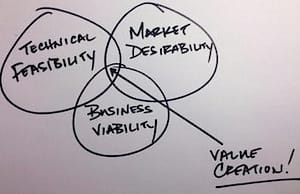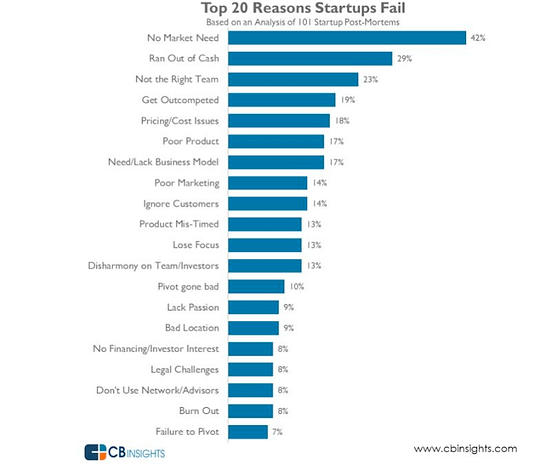MTI + Customer Discovery
 To be successful in the innovation and entrepreneurship arena often requires us to place the rational and analytical in service to the intuitive and inspirational. Vision is critical, but for a vision to manifest into a successful venture, an entrepreneur must quickly find the spot where three lenses – technical feasibility, market desirability, and business viability – snap into sharp focus.
To be successful in the innovation and entrepreneurship arena often requires us to place the rational and analytical in service to the intuitive and inspirational. Vision is critical, but for a vision to manifest into a successful venture, an entrepreneur must quickly find the spot where three lenses – technical feasibility, market desirability, and business viability – snap into sharp focus.
The startup process has changed over the last 10 years and the discipline of marketing has become integrated into the earliest stages of business creation. That is, for the businesses who want to make it past the ditch of death.
In an analysis of 100+ startup failure post-mortems published recently on the web, the most common issues have their root in a lack of market desirability – i.e. “people didn’t want to buy the product” or “couldn’t get customers / couldn’t make enough money”

Prioritizing A Marketing Pre-Mortem
The basic economic laws of startups are as immutable as those of physics. To win at the commercialization game there must be proof that an idea works not just on paper, but also in the marketplace and at the bank. With a more rigorous application of the scientific method to customer and business model development (aka a Pre-Mortem) many of these stories could have ended differently.
Startup teams who succeed are dedicated to making the key assumptions in their demand models visible at the earliest stages.They systematically test the market to see what works and what doesn’t. Like good scientists, they constantly formulate, test and evolve hypotheses.
A Basis for Marketing
“The customers had way more insights than we had. They had been thinking about their own problems for so long…If you just go out and try to sell maybe you’ll find some buyers, but you won’t be learning about what you should be doing.” Lee Redden – Blue River Technology.
In early stage marketing, a business must be relentlessly focused on creating an evidence base to demonstrate market desirability. In order to avoid the trap of efficiently executing the irrelevant, it is important to make sure that spending on product development and staffing does not get ahead of customer development.
Evidence-based customer development forms the basis for a company’s market desirability. It is as iterative and non-linear as any product development process. But just like good product development, there is a gated, step-wise progression that can guide us.
Step 1: Do People Care About My Problem?
The great news is you do not even need a product to test to pass the first gate! From the moment the business plan or canvas is off the presses, the process of customer development begins. The first test is to generate enough real evidence that real people care about the problem you are solving.
By real evidence, I mean first-person interviews (complete with videos, pictures, and audio recordings), online surveys and other direct feedback to demonstrate that the problem – in their own words – gets as close as possible to being one that they deem severely painful, extremely important to them and essential to solve.
By real people, I mean real live representatives of each customer segment you have defined that do not include your friends or family. Push yourself to gather as many as 30 case studies in each segment to ensure that you get broad enough feedback.
When you have observed and verified the evidence demonstrating how your customer/s define the problem and how important it is to them, then the testing of your proposed solution can begin in earnest.
If you do not test your problem statement before you test your solution, you run the risk of missing key insights into the emotional, social, and practical obstacles and opportunities that could make the difference between whether your business joins the zombies at the Walking Dead Bar & Grill or the pink fluffy unicorns on Necker Island.
MTI Funding To Fuel Step 1
MTI’s TechStart grant is designed to help promising companies with this important work. When done correctly, the evidence generated will propel your business into the next stages of market and investment readiness.
Sample customer development elements of a TechStart project could be:
- Design experiments for testing hypotheses re; market desirability
- Build PowerPoint prototype present to 100 potential customers in segment 1 to verify design concept(s)
- Re-rationalize assumptions about the size of the market (ex: total addressable market)
- Validate MVP (Minimum Viable Product) approach
Step 2: Does My Product Offer a Compelling Solution?
With reasonable clarity that people care about the problem, and a deeper understanding of what part(s) of the problem they care about most and why, the next test is to generate real evidence that your product will address that problem and that there are enough customers willing to pay for the product…and all for the lowest cost possible.
MTI is regularly seeing solid approaches to low cost, early stage product development. But, in the context of proving market desirability, consider the value of staging + focusing your prototyping process. An early stage MVP can be a white board with sticky notes or a basic two-page website. It can be a prototype process that relies on tongue depressors, duct tape, and pipe cleaners or a fully functional single feature app. A great thought starter on low-cost prototyping methods is here, courtesy of Stanford’s Design School.
During this stage, you’ll be relentlessly focused on gaining evidence of making positive measurable impact on the problems you’ve validated. You’ll seek data that proves in this market you are as close to a “need to have” as you can be. How much are you saving your customers in terms of time, money or effort? How are you helping them sleep better at night? What risks are you helping them avoid and can you quantify that impact? How long does it take you to get those results and does that exceed their expectations?
A common mistake at this stage is to move out of a discovery mindset during this stage and into “sales mode”. Instead, think like a scientist. Sales are one important indicator of product market fit – so before you move out of this stage, you should have paying beta customers. But, before you scale your customer acquisition activities, be sure you’ve spent a good amount of time verifying your assumptions about who your customers are, how they are using your product and how enthusiastic they are about it.
MTI Funding To Fuel Step 2
Thinking about applying for a Seed Grant? Make sure that you are addressing both the product development and customer development activities that you’ll be taking on during the course of the project. Part of your Seed Grant funding can + should be allocated to developing the case for market desirability.
Sample customer development elements of a Seed Grant R&D project could be:
- Acquire 250 (alpha/beta) customers in Segment 1 via digital channels in order to demonstrate customer enthusiasm for product
- Design experiments to gauge channel partner projections
- Design tests to verify features necessary in next-stage high fidelity MVP for segment 2
- Enhance onboarding User Interface to improve conversion from free to paying customer
The whole goal of the first two steps of the process is to make sure that your many hypotheses about what could be a great business have been sufficiently tested. You are in MAJOR search mode here – you want to make sure that you have something that people just can’t get enough of…
Remember that in one study of 400 startups, 45% of initial hypotheses they had about their businesses were wrong. These two steps are critically important to the long-term health of your business. This is an iterative process and you should not pass go, or collect $200 unless you have reached that point where you feel an intensity of market desirability.
You think you’ve got that? Great!
More on the steps to prove it before you really spend the money to scale next…